I am developing some application like Runtastic Pedometer using the algorithm but I am not getting any similarity between the results.
my code is as follows:
public void onSensorChanged(SensorEvent event)
{
Sensor sensor = event.sensor;
synchronized (this)
{
if (sensor.getType() == Sensor.TYPE_ORIENTATION) {}
else {
int j = (sensor.getType() == Sensor.TYPE_ACCELEROMETER) ? 1 : 0;
if (j == 1) {
float vSum = 0;
for (int i=0 ; i<3 ; i++) {
final float v = mYOffset + event.values[i] * mScale[j];
vSum += v;
}
int k = 0;
float v = vSum / 3;
//Log.e("data", "data"+v);
float direction = (v > mLastValues[k] ? 1 : (v < mLastValues[k] ? -1 : 0));
if (direction == - mLastDirections[k]) {
// Direction changed
int extType = (direction > 0 ? 0 : 1); // minumum or maximum?
mLastExtremes[extType][k] = mLastValues[k];
float diff = Math.abs(mLastExtremes[extType][k] - mLastExtremes[1 - extType][k]);
if (diff > mLimit) {
boolean isAlmostAsLargeAsPrevious = diff > (mLastDiff[k]*2/3);
boolean isPreviousLargeEnough = mLastDiff[k] > (diff/3);
boolean isNotContra = (mLastMatch != 1 - extType);
if (isAlmostAsLargeAsPrevious && isPreviousLargeEnough && isNotContra) {
for (StepListener stepListener : mStepListeners) {
stepListener.onStep();
}
mLastMatch = extType;
}
else {
Log.i(TAG, "no step");
mLastMatch = -1;
}
}
mLastDiff[k] = diff;
}
mLastDirections[k] = direction;
mLastValues[k] = v;
}
}
}
}
for registering sensors:
mSensorManager = (SensorManager) getSystemService(SENSOR_SERVICE);
mSensor = mSensorManager.getDefaultSensor(
Sensor.TYPE_ACCELEROMETER);
mSensorManager.registerListener(mStepDetector,mSensor,SensorManager.SENSOR_DELAY_NORMAL);
in the algorithm i have different levels for sensitivity as public void
setSensitivity(float sensitivity) {
mLimit = sensitivity; // 1.97 2.96 4.44 6.66 10.00 15.00 22.50 33.75 50.62
}
on various sensitivity level my result is:
sensitivity rantastic pedometer my app
10.00 3870 5500
11.00 3000 4000
11.15 3765 4576
13.00 2000 890
11.30 754 986
I am not getting any proper pattern to match with the requirement.
As per my analysis this application is using Sensor.TYPE_MAGNETIC_FIELD for steps calculation please let me know some algorithm so that I can meet with the requirement.
